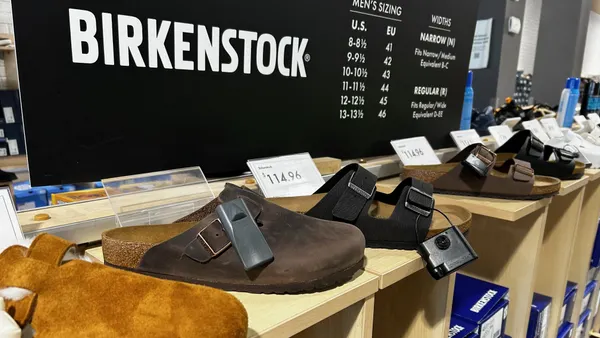Dive Brief:
-
Apparel sales are benefiting from millennials, the strength of the athleisure category and the growth of e-commerce, but those factors weakened last year, according to a report from The NPD Group emailed to Retail Dive. U.S. apparel sales last year fell 2% year over year to $215 billion, according to the report.
-
In 2017, millennials contributed the highest apparel growth rate of all generations at 4%, (or $2 billion in incremental sales), NPD found. But last year that slowed from the double-digit increases seen over the previous two years, according to the report. And while non-activewear sales declined as activewear sales grew in 2017, last year's rise wasn't as steep as it has been: Activewear sales rose 2% to $48 billion (22% of total apparel sales).
-
Finally, while e-commerce remains a "driving force" in apparel sales, considering the decline of apparel sales in physical stores, those stores retain more than three-quarters of annual apparel dollars, according to Slice Intelligence data cited by NPD. The purchase frequency of online apparel consumers increased last year, but they spent 5% less per receipt, according to that research.
Dive Insight:
Americans are spending less on apparel, even in the key athleisure category. Well more than a third (37.5%) of U.S. consumers surveyed by Coresight Research said that clothing is now less of a spending priority. "The prominence of value retailers as switching destinations indicates that shoppers have downgraded apparel as a spending priority," Coresight CEO Deborah Weinswig said in a statement.
Lee Peterson, EVP of brand strategy and design at design firm WD Partners has pinpointed a reason for that: He sees retail in three tranches: discounts, convenience and "third wave," which he defines as a special attribute of cool only attained by cultivating unique designs, aesthetics or experiences. "That's what people want: discount, really convenient or really special," he told Retail Dive in an interview.
And millennials' purchasing patterns are still swiftly evolving, Marshal Cohen, chief industry advisor at The NPD Group said. "The rapid pace of change in millennial consumption is one major change that points back to the importance of evolving consumer segmentation," he told Retail Dive in an email. "The future of the apparel business depends on manufacturers and retailers refocusing on the current needs of each critical consumer segment."
Despite the slower growth in apparel purchases among both millennials and Gen Xers, those two groups were the only generations with increases in apparel dollar sales in 2017, NPD Group found. Baby Boomers, who account for nearly 20% of annual apparel dollar sales, and Gen Z, who generated almost a third of total apparel dollar sales, also both experienced declines in overall spend for the year, according to NPD.
And athleisure, which has seen such strong sales in apparel and even spurred new entrants, like Respect Your Universe, which just announced its first U.S.store, is highly dependent on women, according to that report: Sales of both men's and women's activewear grew in 2017, but women's supplied much of the energy behind the category's growth, reaching $21.9 billion in sales with a 4% increase over 2016.
"Categories like active apparel bottoms, undershirts, and swimwear – which indicate the consumer's concentration on comfort, the staples, and niche products – are the few sources of consistent, long-term growth in today's apparel market," Cohen also said. "Retail is changing, the consumer is changing, and every industry must understand where spending habits have moved, and adapt to the shifting market dynamics that are impacting their business."














